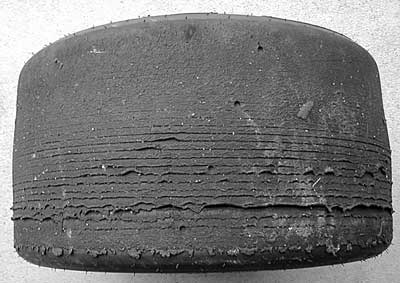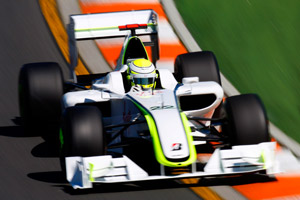Ehh, not really.
If you want to talk graining, you have to understand what is really is first. People, even tire "experts," sometimes throw a bunch of stuff in the "graining" category that really aren't.

This for example, despite the claim, is not graining. I won't get into what exactly it is.
Graining and tearing and stuff like that, can happen just as much hot as it can cold. Take a rain compound for example. You can run it in the wet and it wears perfectly evenly when it's kept cold. Get it too hot on a drying track and it will grain and tear and shred off big strips of rubber at a time.
Any way you slice it, the tread isn't staying in the form it's supposed to. It's tearing apart, balling up, shredding off the tire, whatever. It doesn't have enough strength for what it's being subjected to. Part of that might be on the tire manufacturer for bringing a compound that generally just doesn't have the guts to withstand the ballpark operating range.
Some might be on the setup engineers. Set a car up with excessive understeer on already delicate tires, and it's going to be really easy to saturate and overwork, beat up on the front tires while not getting as much out of the rear.
Part might be on the driver for generally overstressing the tires no matter what temperature they're at.
Or the track, being very abrasive before it's really rubbered in.
People get into this "optimum temperature range" thing and it's really a crock of ---. Nothing is "optimum" in racing. Ever. Or else many people would be out of jobs. Nothing is constant either. Just measuring the "grip" level of a compound is tremendously complex and really not straight forward at all.
Anyone claiming to have an "optimum" temperature for their tires.. manufacturers included.. I am extremely wary of.
Plus, heat is generally NOT good for rubber, or tires. That's how it goes. More heat and longer.. rubber cures more, or it reverts, or generally bad --- happens. The reason why air leaks are such a huge concern is because as the air comes out, the tire deflects more, generates more heat, runs hotter, and then at some point fails.
(So to answer your question, undertread and carcass temps are definitely affectd by tire pressure and load).
Surely you don't want the tire frozen cold, as the rubber will be brick hard or crack or not grip at all. Maybe if you run it "warm" it will have decent performance over an extended period of time. Maybe if you run it "hot" it will have more traction early on and then for one reason or another fall off. Trading one for the other is pretty nebulous and vague.
Grip is a four letter word. All opinions are my own and not those of current or previous employers.




